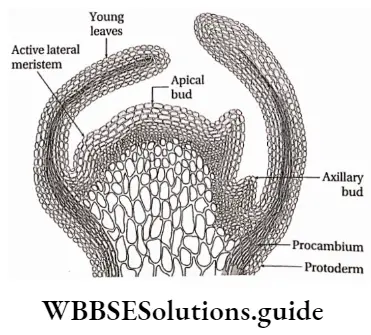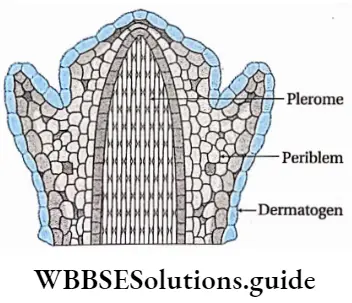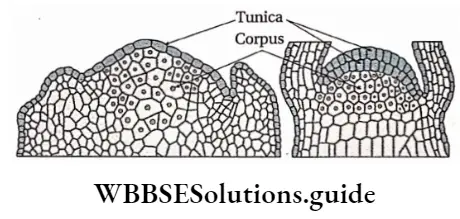Shoot Apex Notes
Shoot apex Definition: The region, situated immediately above the uppermost leaf-forming cell or leaf primordium, is known as the shoot apex.
Shoot apex Characteristics:
- It occurs as a terminal (at the tip of the stem) and axillary bud (at the axil of a leaf).
- The shoot apex is protected by the leaf primordia. Sometimes they are protected by structures called bud scales.
- The vegetative shoot apex is the apical meristem, responsible for unlimited growth to form the different parts of the plant.
- The shoot apex is more or less convex in the longitudinal section.
- It shows changes in shape with the emergence of new leaves. The shoot apex becomes broadened during the initiation of leaf primordia.
- The number of leaf primordia and the direction of broadening of the shoot apex is determined by phyllotaxy.
- The time period between the initiation of two successive leaves is called plastochron. The changes that occur in the shoot apex during this period are; known as plastochronic changes.
- The size of the shoot apex also varies among the seeded plants.
- In pteridophytes, the shoot apex is formed of a single cell, whereas in the case of gymnosperms or angiosperms, it is multicellular.
- Due to reproductive changes, the shoot apex gets transformed into the reproductive shoot apex, During this process, the tip of the shoot becomes swollen and gradually changes into a flower.
Read and Learn More: WBCHSE Notes for Class 11 Biology

Theories related to the structural organisation of shoot apex: To explain the structure and activity of shoot apex, many theories have been propounded by different scientists. Some important theories related to the structure and activity of shoot apex are discussed below.
Histogen theory: The histogen theory was propounded by Hanstein (1868). He distinguished the shoot apex of angiosperms into three zones. These zones are known as histogen (Greek: histos=’tssoe’ gennaein=’to produce’). The three zones are
- The outermost single layer or from which the epidermis of the stem and leaf are formed is known as dermatogen.
- The middle zone from which the endodermis and cortex develop is known as the periblem.
- The central history, from which the stele (the core of the plant made up of pith, vascular bundles and pericycle) develops, is known as the plerome.

1. Tunica-Corpus theory: Schmidt (1924) proposed the Tunica-Corpus theory for the angiosperm shoot apex development. According to this theory, the shoot apex is divided into two regions, the tunica and the corpus.
Tunica is the outermost layer of the meristematic tissue, formed of one or more cell layers. The tunica surrounds the inner cell mass—the corpus. Cells of the tunica region are smaller than the cells of the corpus region.
The cells of tunica divide anticlinally. If tunica is single-layered, it forms only the epidermis. If it is multilayered, the epidermis evolved from the outermost layer, while the inner layers took part in the formation of leaf primordia and cortex. The tunica enlarges the surface area.
2. The corpus is the central mass of cells surrounded by tunica cell layers. The corpus cells are larger. They divide in various planes so that a mass of irregularly arranged cells is formed, hence corpus increases in volume.
The corpus develops from its own initials situated beneath those of tunica. The corpus zone gives rise to the pith, the vascular bundles and a part of the cortex.


